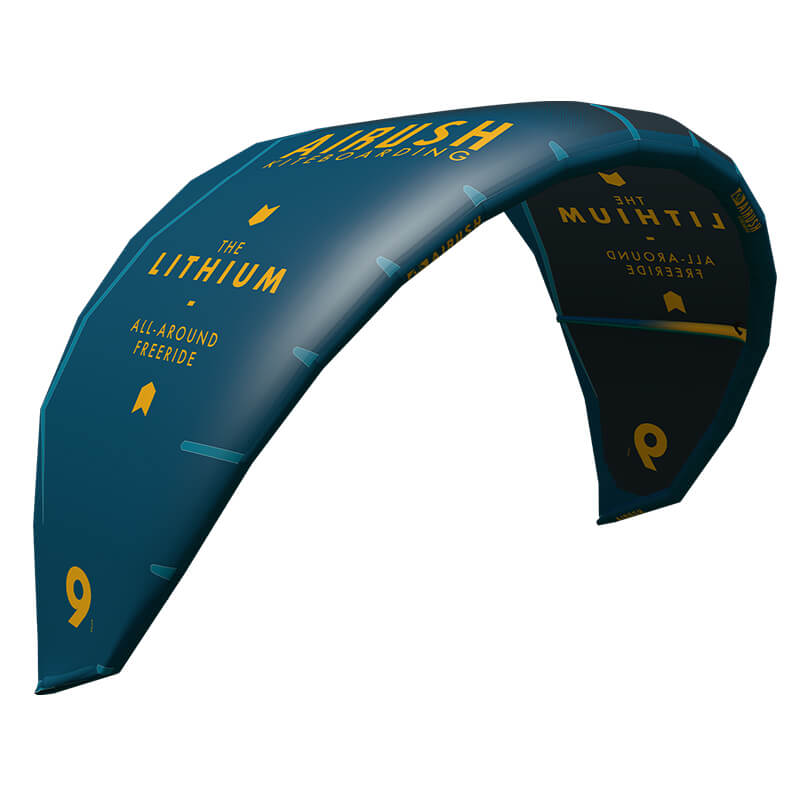When you purchase gear through links on our site, we may earn a small commission. Here’s why you can trust our tests and our affiliate partner.

The Airush Lithium is a kite model now stretching back well over a decade and with an extensive back catalogue of iterations to rival Paul McCartney. The V13 heralds a ground-up rebuild rather than a refresh and tweak. The design intention is the same as ever – a versatile and universal freeride kite with enough performance to keep the more seasoned rider excited, but this year’s has been augmented to cater for current market trends, including hydrofoil use.
The Lithium is built on a three-strut platform, and shape-wise we’re looking at a flattish arc and mid-depth profile in the center of the canopy. There are elongated and swept wingtips that extend quite a way backwards, which is something of an Airush signature, having just spent time on the new Ultra. This seems to enable a good leeward tendency and fore and aft balance to the kite. Industry benchmark Teijin D2 Ripstop has been implemented across the canopy, and the load frame which is found in other kites in the Airush line up is absent which is likely a weight saving move and to help the kite twist and turn. The trailing edge has an interesting construction with a generous application of Dacron along the full length into the wingtips which extends fairly deep back into the canopy to an apex at the mid-point between the struts, blending into a seam. At the junction of the ripstop and Dacron there’s an intermediate layer of mark cloth, which is a prime example of the overall level of thought that has gone into the build and long-term durability prospects of the kite. Attention has been paid to the bridle this year during R&D, and no less than three pulleys per side do a great job of balancing and controlling the arc shape as well as enabling a huge angle of attack change on sheeting. Two settings are present on the leading edge to adjust the bar feel, which are simple enough to change via the toggles as you rig, and have a dramatic effect on handling weight. The lighter settings seem to allow a little more twist through the airframe to make the turning playful and pivotal.
We were blown away by the Lithium’s smooth power delivery and all-around easy-going nature. On the beach it’s extremely well behaved in gusts, and has no overflying tendencies, even when you push it. There’s that consistent background presence you feel through your harness which doesn’t seem to build obnoxiously as wind speed increases. It’s the type of kite that makes sportive freeriding an uncomplicated experience and will bolster twintip progression well into intermediate level hooked tricks. The kite has a surprising amount of straight lift, and the best part is it’s very easy to access, and smooth and predictable in ascent and descent. You can run into a take off without much speed and just use the sheet for lift. There’s not much talent required to get some solid WOO scores, and your knees will thank you for it. In the light handling mode, for someone doing their first hooked kiteloops, the kite whips round and climbs very consistently, and it would make a great platform for those with Big Air aspirations, who don’t want to take the kickings associated with a more aggressive kite.
Its balanced nature, leeward tendency and agile turning means you can take it into a wave scenario with confidence and not have to adjust your riding style to a completely different wave-specific kite. In the low end the Lithium maintains its composure well and the weight saving in the V13 has paid dividends. For the hydrofoil dabbler, the inherent stability overhead, and reassuring background pull for transitions, combined with that important sporty handling results in a solid platform for freeride foiling.
The Lithium is a confidence inspiring sheet-and-go marvel, with sportive handling and a playful nature. It’s an uncomplicated genre spanning tool that is performant enough to keep even the most seasoned freerider engaged, and sports a wide application of potential use across twintip, wave and foil disciplines.
